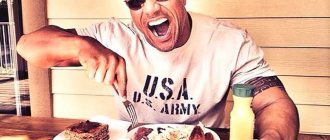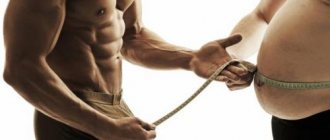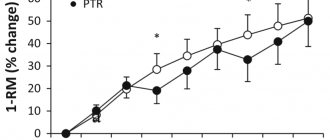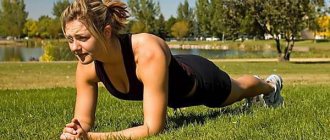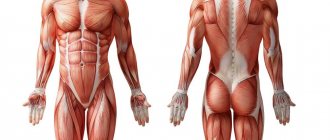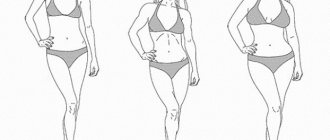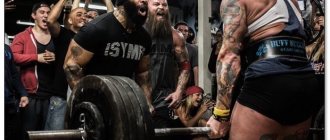Author: Timko Ilya - the ruler of the entire site and fitness trainer | more details >> Rod. 1984 Trained since 1999 Trained since 2007. Author and creator of the site tvoytrener.com. CCM in powerlifting. Champion of Russia and South Russia according to AWPC. Champion of the Krasnodar region according to IPF. 1st category in weightlifting. 2-time winner of the Krasnodar Territory championship in t/a. Author of more than 700 articles on fitness and amateur athletics. Author and co-author of 5 books.
Place in the author rating:
out of competition
(become an author)
Date:
2019-05-27
Views:
4,377
Rating:
4.2
| All articles by the author >> | Medals articles >> |
Articles are loading...
Quite often I am asked this question. Most of these questions are related to the asymmetry of the arms and legs. That is, one leg or arm is thicker than the other. They also often write about the different sizes of the pectoral muscles. Less commonly, there is a difference in the back (latissimus muscles). Even less common are the shoulders. But, one way or another, asymmetry can affect all paired muscles. As for the difference in arms and legs, almost everyone has it. And the reason for this is the most common cause of asymmetry, which will be discussed below.
Asymmetry may appear
- in a specific sport (for example, tennis, golf), where one side of the body is involved more than the other; - when an athlete performs the same type of actions over and over again - this is the so-called biomechanical reason for repeated movements in one direction or prolonged poses; - due to neuromuscular imbalance due to the predisposition of individual muscle groups to be strong or weak; - people with limbs of different lengths.
These are some of the possible causes of muscle asymmetry; the curvature of the spinal column also makes a significant contribution - deviation of parameters from the norm. Look at the physiological signals corresponding to muscle activity (EMG) and heat maps of the human body of the ideal and standard case.
Such images help doctors identify patients with soft tissue injuries, imbalances in muscle development, and the degree of spinal curvature.
It is worth saying that there are no ideally “even” people and this is due to the intrauterine development of the fetus. We are all initially in a curled-up position in the womb, and already there the degree of “curvature” of our spine begins to be established.
Therefore, if you think that scoliosis (lateral deviation of the spine from the normal straightened position) is purely your thing, then this is not so, almost everyone has it, only its degree varies.
Main symptoms and treatment methods for stage 2 scoliosis
Have you been trying to heal your JOINTS for many years?
Head of the Institute for Joint Treatment: “You will be amazed at how easy it is to heal your joints by taking every day...
Read more "
If a patient has grade 2 scoliosis, it becomes clearly visible to the naked eye. A non-medical professional might call this a “severe curvature.” In essence, this is true, but the signs of scoliosis, like the disease itself, tend to progress.
The problem can manifest itself already at primary school age, from 8 to 11 years. In such situations, it is much more difficult to carry out the necessary treatment and correct posture, since the body is constantly growing, and the spine along with it. Scoliosis diagnosed at an early age can be treated, but it is extremely difficult to cure. If you cannot cope with the disease, you can expect problems with the chest and respiratory tract in the future.
In other cases, grade 2 scoliosis begins to appear only at an older age and is diagnosed by the age of 18 or later. Then the treatment is faster and easier, the result is often positive.
Symptoms and types
Any degree of scoliosis is a progressive curvature of the spine, usually in several places at once. There are 4 degrees, and each of them is determined by the degree of the displacement angle. If the degree of scoliosis is 2, this implies a deviation of 11-25 degrees.
Such a curvature is clearly visible during examination, but in everyday life it can remain unnoticed for quite a long time. People around him do not see him, since deviations are hidden by clothing, and even more so when moving. But it is during this period that there is still time and the opportunity to recognize grade 2 scoliosis in order to begin treatment.
To detect scoliosis, you need to have someone examine your back.
- You need to stand up straight, lower your arms along your body. It is important that the body weight is distributed evenly and there is no increased load on the right or left leg. Only in this case will it be possible to correctly recognize the symptoms of scoliosis.
- Carefully consider the distance between your arm and waist. Compare it with the same distance from the waist, but already regarding the second hand. If a person has developed grade 2 scoliosis, asymmetry is observed.
- To identify, you can use a tape measure, which will need to measure the distance from the shoulder blades to the floor and from the shoulders to the floor. In the presence of grade 2 scoliosis, asymmetry may also be present here. The larger it is, the more serious the situation. However, it is too early to sound the alarm if this is the only indicator: it is a sign of other problems, not necessarily scoliosis.
- Sometimes asymmetry is observed in the area of the gluteal folds. Most often, such symptoms are characteristic of children; in adults they are not so pronounced. In addition, this sign may also mean the presence of other ailments other than grade 2 scoliosis.
- Next, you should ask the patient to stand with his back to the wall and facing the person who is checking him for scoliosis. He needs to slowly lean forward, doing it smoothly - first, as if in a semicircle, pull his neck down, then the upper part of the spine, then the lower part. Just hang your arms down, relaxing. Stop approximately when your face is just above your knees. Now the examiner should look at the back, crouching so that it is at eye level. If in this case the left or right half of the back appears higher, these are significant symptoms that scoliosis is present.
It is easy to carry out such a check at home. The above are the main symptoms by which stage 2 scoliosis can be identified. But this does not always give the right result. The inspector may be biased. It is better to consider such an examination as basic, and scoliosis should be diagnosed and treated by a specialist.
Sometimes additional symptoms may include discomfort or even pain in the back. But such manifestations are rare, and the patient often adapts to them and stops noticing them - at least when it comes to inconvenience.
Types of scoliosis
Curvature differs primarily in shape.
- If a person has s-shaped scoliosis of the 2nd degree, it means that the spine is curved in both directions, approximately in the shape of the letter “S”.
- C-shaped - when the back is curved in only one direction.
- Less common than those listed above is the Z-shaped one. In this case, the spine is curved in three places at once.
Scoliosis is also classified into different types according to:
- localization of curvatures;
- time of manifestation according to the patient’s age;
- origin.
Separately, it should be noted such varieties as fixed and non-fixed. The first is considered more complex and difficult to treat, and it also creates more problems for the patient. If you have fixed scoliosis, then the vertebrae are deformed and twisted.
This variety is difficult to treat, but there is still room for improvement. Doctors divide fixed scoliosis into stable and unstable. The type of treatment that will be prescribed depends on the type. An accurate diagnosis can only be made in a clinic.
Dysplastic scoliosis, or discogenic, also requires special attention. Its distinctive feature is that it is associated with disorders of the development of connective tissue. Today it is associated with hereditary factors. If a person has dysplastic scoliosis, this means that the connection between the intervertebral discs and the vertebrae is impaired; usually accompanied by disc displacement.
The same banned issue for which Ernst fired Malakhov!
Joints and cartilage will be cured in 14 days with the help of ordinary...
Treatment of scoliosis
A patient who requires treatment for stage 2 scoliosis must have a complete understanding of what his diagnosis is and what specific disorders he is being treated for. This is important because:
- Each individual case may have its own specific approach to recovery;
- with complete information about the disease, you can easily contact additional medical institutions, for example, Tibetan medicine centers;
- When you self-medicate, you will be less likely to treat yourself for the “wrong thing.”
Although the methods used vary, there are basic methods used in most cases.
Surgical treatment – for advanced cases
Scoliosis is not treated with medications, except for taking vitamins and minerals in some cases. Therefore, if the disease is advanced, surgery is prescribed. Its essence is to install a special system that will fix the vertebrae.
Typically, such an operation is prescribed for grade 4. But there are exceptions: disturbances in the functioning of internal organs due to the development of the disease, as well as its too rapid progression. The decision to undergo such an operation is made individually when cure is not possible.
Physiotherapy
Therapeutic exercises for grade 2 scoliosis are simply necessary. It is not the main point for recovery, but it helps improve the results of all other methods. It should not be used as the only remedy. When the disease is detected at the first stage, if the approach is serious, this is still possible, but not at the second. But with an integrated approach, you can use it to first stop the disease and then make it recede.
It’s easy to find good exercises for the spine today: there are plenty of books in stores and videos from professionals on the Internet. The main thing is that when selecting exercises that can correct curvature, carefully ensure that they relate specifically to the spine and scoliosis. Your doctor can also give you instructions.
Gymnastics is not an easy treatment; it requires willpower and determination. It will help correct both c-shaped and s-shaped scoliosis, but only if you practice regularly and for a long time. This means from 2 times a week for 30-45 minutes, and so on for many months or even a couple of years, depending on how advanced the situation is and what the accompanying treatment will be. With the proper approach, fixed and dysplastic scoliosis can recede.
Corrective corsets
The number of offers of various corsets today is huge. They are especially popular for weight loss. So why not use the idea for more noble purposes? It was in order to simplify the treatment of grade 2 scoliosis that spinal corsets were invented.
They do not have much therapeutic effect, however, if you wear them constantly, the patient begins to get used to keeping his back in the correct position. This is already a good prerequisite for the start of recovery; the most important thing is that the progress of the disease stops.
Manual therapy
Manual therapy has a very good effect. If you are wondering how to treat grade 2 scoliosis, be sure to include it in the list of methods. With its help you can correct your posture, but it is important to find a good specialist. It's worth spending time on. A professional will restore your health, an amateur or someone who is not a worthy specialist will only worsen the situation.
Massage
Since treating scoliosis of the 2nd degree is not an easy task, and also urgent (after all, it is about to go to the 3rd degree), you can and should use a maximum of methods. One of them is massage. It must be professional and medical. Only there can the situation really be corrected, and not worsened.
Other non-drug treatments
In addition to the above, other methods are also used.
- Electrical stimulation of the back muscles.
- Positional therapy.
- Reflexology.
- Electrophoresis.
- Thermal procedures.
- Swimming is a small, but still help for those who want to cure scoliosis.
Most methods are prescribed by your doctor. Some procedures cannot be performed in a hospital because suitable equipment is not available. If you have the opportunity to find this in other clinics, even paid ones, be sure to take advantage of every chance. This is especially important for complex cases such as dysplastic and fixed scoliosis.
Treatment of fixed scoliosis
Fixed scoliosis is detected using the features of the captured radiographs. To do this, two photographs are taken: standing and lying down. If the difference between them is more than 5 degrees, this indicates that the scoliosis is fixed.
Today it can be treated with the following methods:
- K. Schroth method;
- kinesio taping;
- Corrective Voito therapy.
The methods are selected by the attending physician depending on the characteristics and causes of fixed scoliosis in a particular case.
When scoliosis has reached only 2 degrees, it can be cured, although it is more difficult than with 1 degree. But waiting for further development is the height of irresponsibility in relation to your health. Therefore, immediately begin the path to recovery, and your doctor will help you with this.
Muscle asymmetry: what, why and why
Human movement and function require a person to balance muscle length and strength between the opposing muscles surrounding the joint. Most joints in our body have two or more separate and opposing sets of muscles acting on it.
Muscular balance is the equal amounts of opposing forces between muscles that are necessary to maintain a concentrated (centered) position of a bone in a joint during movement.
On the other hand, muscle imbalance occurs when opposing muscles provide different directions of tension due to tightness or weakness.
To understand what we are talking about, look at the following images.
As for the general asymmetry, it can be different, in particular the following:
- front and back - for example, the back lags behind the chest; - left and right - one arm/leg is larger than the other; - upper and lower body - massive upper body on chicken legs.
Regarding muscle groups, asymmetry is most often observed between:
- lower leg and arms; - biceps and triceps; - trapezius and shoulders; - heads of deltas (anterior, middle, posterior); - triceps heads (lateral, medial, long); - forearms and upper arms.
What is Poland syndrome?
Poland syndrome was described more than a hundred years ago and is quite rare, estimated to occur in 1 in 20,000 births. Poland syndrome is a congenital condition involving a spectrum of anterior deformities of the chest wall, ribs, and soft tissues on one side of the body. In addition, deformation of the arm and hand may occur.
Poland syndrome can range from partial absence of the pectoral muscle to complete absence of muscle.
In the most affected individuals, a large section of the muscle that usually runs from the shoulder to the sternum is completely missing. Typically, when the pectoral muscle is absent or underdeveloped, the overlying breast is absent and appears small or deformed.
Poland syndrome occurs three times more often in men than in women, and the right side is affected twice as often as the left. Mild cases of Poland syndrome may not appear until puberty, when chest asymmetry becomes more obvious. In contrast, severely affected individuals have abnormalities that are evident at birth. The nipple and areola of the affected side of the breast are usually smaller and higher than those on the other side, or may even be absent.
Women with Poland syndrome may have mild to severe breast asymmetry. Girls with this problem can and even should receive breast implants at an age much earlier than implants are usually used in order to reduce asymmetry. In men with Poland syndrome, the absence of the pectoral muscle creates both cosmetic and functional defects.
Muscle asymmetry in the early stages of training
As soon as you begin to perform an exercise, the brain makes an assessment of which side of the body is easier for it to perform the task. The body then establishes a favorable pattern of movement (stores it into memory), as a result of which the increase in strength and volume occurs unevenly - the most frequently used areas increase faster.
Over time, the fine line increases, as a result of which the muscle group constantly “pulling out” the load becomes dominant (stronger, more durable, more voluminous). This is how asymmetry arises.
How to prevent muscle imbalance?
Bodybuilding is not just muscle mass - it is, first of all, ideal proportions and symmetry. Of course, mere mortals do not necessarily become sculptures with ideal circle shapes, but acquiring some aesthetic physique would not be bad.
Actually, let's do this.
So, there are two types of movements that can be done - bilateral and unilateral. Bilateral - when an athlete uses two limbs (arms, legs) at the same time, for example, lifting a barbell for biceps.
Unilateral - when one limb is used, for example, lifting a dumbbell with a hammer grip. Sometimes muscles grow more on one side than the other and this is due to the dominant side of the body. The presenter always tries to override and do all the work. If we talk about arms/legs, then for right-handed people the leading one is the right one, for left-handers, respectively, the left one.
To bring balance, i.e. to pull equally on different sides (and equalize the volumes), you must adhere to the following tips:
Implant placement
Breast implants are typically inserted endoscopically through incisions made in the armpits so noticeable scarring can be kept to a minimum. Through an incision, the surgeon can create a cavity between the layers of the pectoral muscles. He will place the implant in this space. The muscle is not separated from the rib cage or sternum (as is done when placing a female implant).
Female implants are placed below the lower edge of the pectoralis muscle to create the lower pole of the breast shape. Conversely, male implants are placed only to the level of the lower border of the muscle, creating a large bulge of the pectoral muscle, and never below. In fact, they are placed just above the level of the nipples. The muscles hold the implants in place, preventing them from moving. The implant is placed under the pectoral muscle, which smooths out all the edges of the implant so that the breast looks smooth and natural.
Increasing the strength of the weak side
When performing exercises, try to consciously place a greater load on the lagging muscles, as if pulling them towards the dominant ones.
For example, if there is asymmetry in the chest, you can perform a bench press with different weights on the sides, the larger one is 3-5% on the lagging one. For example, your left chest is larger than your right, in this case we throw 52 kg on the left, and 50 kg on the right and press in this mode.
You can do the same with dumbbells. Regarding biceps asymmetry, you can do this. When doing a barbell curl, move the arm with the smaller biceps muscle closer to the center of the bar and leave the other one in place.
What is Pectus Excavatum?
Pectus excavatum anomaly, more commonly known as sunken chest or pectus excavatum, is a congenital deformity in which the sternum collapses inward during growth. Some people with Pectus excavatum have a slight indentation in the chest, but others may have breasts that appear deeply dented, concave, and asymmetrical.
Although the cause of the anomaly is unknown, Pectus excavatum is common in several family members and is therefore inherited. The anomaly occurs more often in men than in women. The problem is often noticeable as early as infancy, typically worsens during adolescence as the body grows, and may continue to progress into adulthood.
Plastic surgery to correct the defect involves placing an implant under the skin and soft tissue of the chest. Correct placement of implants gives the chest an almost normal appearance.
